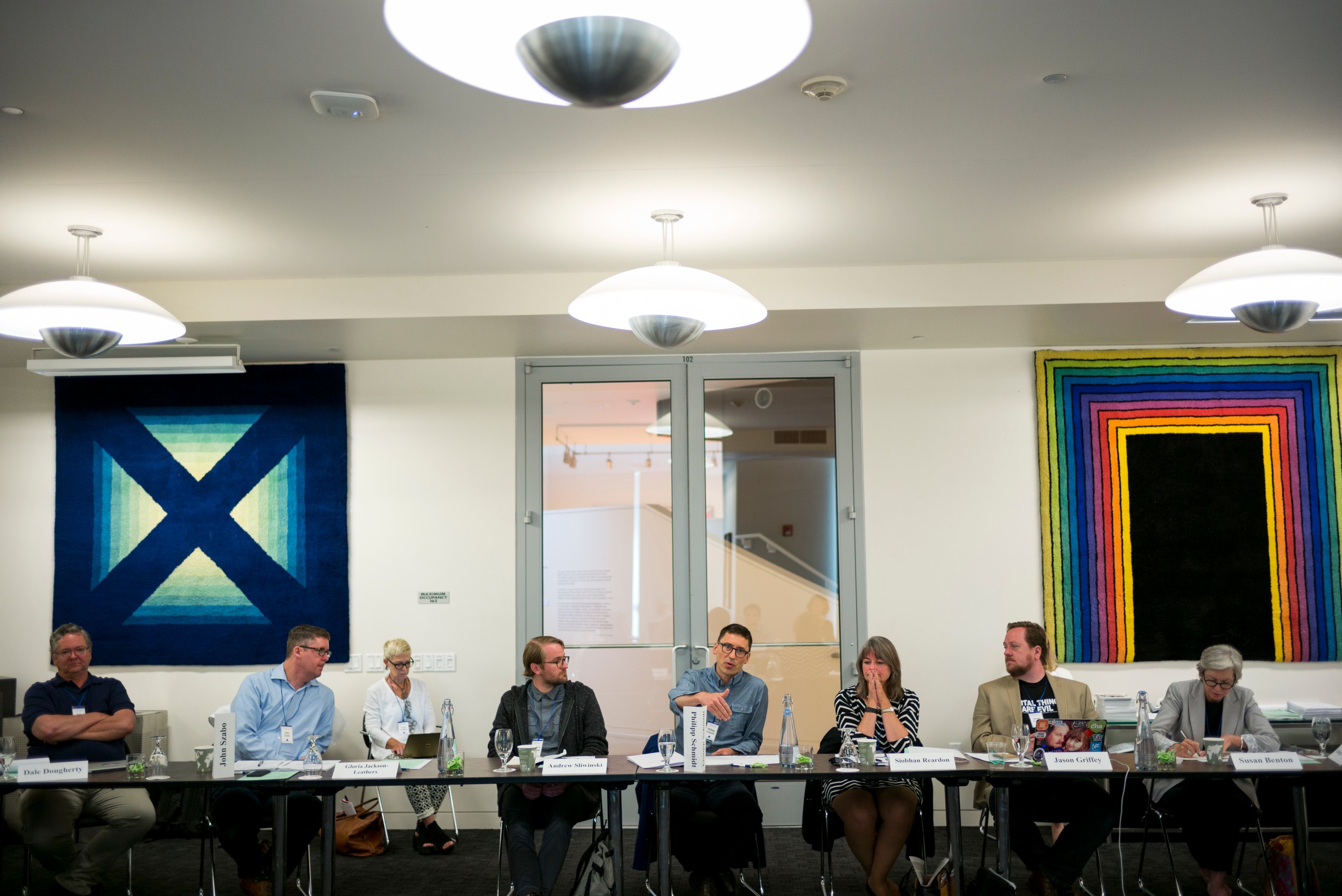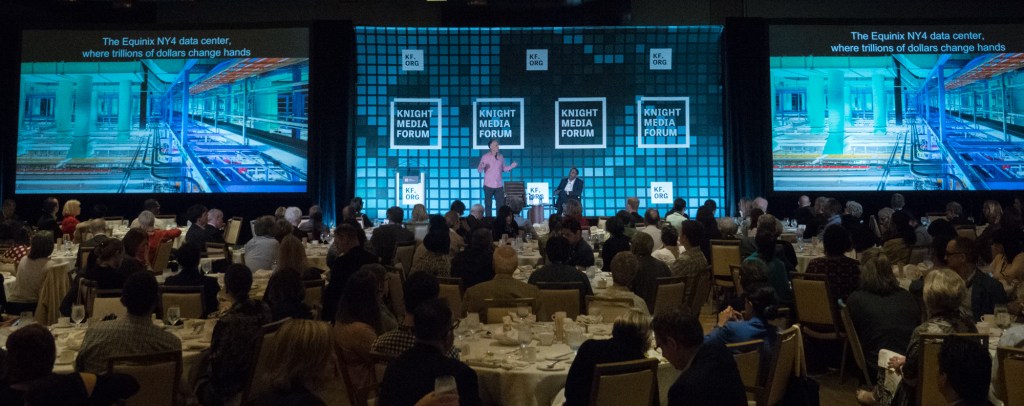
Libraries of the future: Super connectivity and a national stature

Photo credit: Daniel Bayer for Aspen Institute
This post has been updated.
What will your local public library look like in the future? A digital-age gathering place that’s still a monument to the printed page? Perhaps shed of its physical walls and transformed into a virtual library, accessed by patrons from their homes, businesses or open public spaces? Or…?
The sentiment is nearly universal that the public library – open to and serving all strata of a community – is an asset and public treasure to be protected as well as updated as it necessarily transforms for the digital age.
In the mountains of Colorado last week, a group of library leaders were joined by thought leaders and decision-makers from government, technology, business, academia and philanthropy to consider and plan for the future of the public library. Assisted by facilitators at the Aspen Institute, participants in the Leadership Roundtable on Library Innovation, part of the Aspen Institute Dialogue on Public Libraries and supported by Knight Foundation, worked over three days on proposals to guide libraries through a difficult march toward future relevance.
“Libraries are a tremendous asset that haven’t been leveraged in the best way in the digital age,” said one roundtable participant. (Aspen Institute etiquette prohibits directly quoting participants to protect freewheeling discussions.) … “Libraries need to develop a much greater sense of urgency.” … “Libraries must iterate all the time. They no longer can innovate and then expect that to last five years.”
The need for super speed
There are about 9,500 public libraries in the U.S., most of them serving small and medium-sized communities. Probably 8,500 of them are not interested in innovation, suggested one urban library director. But not to innovate aggressively is a huge mistake for libraries in an era when digital information technology and the exponential growth in computing power are transforming industry after industry. Most of those gathered in Aspen believe that libraries also will be radically disrupted.
While roundtable participants overwhelmingly agreed that the physical buildings housing libraries remain as relevant as ever – albeit in the future as a community convening place more so than a mere repository of books and physical media – digital connectivity to the world of data is becoming just as important, if not more.
One of the primary recommendations coming out of Aspen is that more libraries (big and small) acquire “super connectivity,” which means adding 10-gigabit connectivity to the Internet. Such a library would have massive capacity (via fiber optic connections) for data transfer in and out of the building. A library with super connectivity would have the capacity for patrons to always be able to view streaming video without today’s common glitches and delays, no matter how many people in the library are watching video at one time, for example.
People looking for guidance and resources to start new businesses and advance their careers already use libraries abundantly. Super connectivity holds the potential to turn the community library into a super economic development hub open to people of all income levels. The roundtable proposal envisions people collaborating at the library on business creation, enabled by the free high bandwidth available plus other library resources. A strong beneficiary of library super connectivity would be the maker movement. Because the library serves everyone, opportunities are available to those who cannot afford commercial connectivity offerings, allowing libraries to play a bigger role in lessening income inequality.
A future example of super connectivity’s potential could be that libraries across the U.S. build virtual meeting rooms, where holograms and 3-D imaging are used for people dispersed physically to meet in a format as good as or perhaps better than in-person meetings – at much lower cost and minus travel time. With a free or low-cost telepresence meeting space in every community with a library, business creation as well as other forms of long-distance collaboration would boom. While “Star Wars” Jedi Council-like hologram virtual meetings aren’t here yet, telepresence meeting technology is, but requires super high-bandwidth connections. Opportunity: libraries.
Yes, libraries can afford it
Conveniently for libraries, the next few years are the best time to make the jump to super connectivity. Even small libraries can consider it, courtesy of the $3.9 billion Schools and Library Program of the Universal Service Fund, known as E-Rate, administered by the Federal Communications Commission (FCC). E-Rate offers discounted telecommunications, Internet access and internal connections. Eligible schools and libraries pay between 10 percent and 80 percent of the cost, with the average cost borne around 20 percent (when state matching funds are available). E-Rate money is meant for investment rather than to pay for services; libraries would look at building their own connectivity infrastructure, including expanded Wi-Fi service within their buildings.
Jonathan Chambers, the FCC’s chief of the Office of Strategic Planning and Policy Analysis and an Aspen roundtable participant, said that libraries have received a tiny percentage of E-Rate funds compared to schools. The reason is simply that most libraries haven’t applied. The application process is complicated and libraries typically don’t have the internal technology expertise required to successfully apply for funds. However, there are consulting firms that specialize in assisting E-Rate applicants.
‘America’s civic square’
Another recommendation coming from the Aspen roundtable tags along with super connectivity. Libraries can and should focus more on regional and even national collaborations. Think not just what a library can do for its immediate community, but also about what libraries can do as a group, suggested one roundtable participant. Topic areas such as immigration integration, for instance, typically are important to more than a single city in a region, so collaboration on curating and creating materials will produce a more valuable set of resources, including joint discussions and educational events.
Extending the idea of increased library collaboration, the Aspen participants proposed an “America’s Civic Square” program – an infrastructure and platform that would connect libraries nationally. They view the value in going national as a way to enhance the stature of libraries in informing people on and tackling issues of the day.
Such a national library collaborative could respond to crises, from climate-change impacts to policing problems. The product of such a collaboration using the America’s Civic Square platform could include: simultaneous events at libraries across the country; exhibitions; collections of resources and personal stories; shared interactive databases; shared children’s programming; etc.
Roundtable participants view such a national initiative as a way for libraries everywhere to get involved in societal issues that can be controversial – yet remain impartial and neutral while informing their communities. Libraries could, for example, dive deeper into hosting forums in person and online. They could provide services around issues that support community members; for example, offering assistance in simplifying immigration applications.
But above all, the library of the future will be better integrated with other libraries, with a national layer built on top of the many assets of local libraries.
More work to be done
The Aspen libraries roundtable resulted in many more recommendations, including how to change library cultures that may be resistant to significant change. Identified as critical to libraries’ transition to the digital, high-bandwidth age are adding to the staff innovators who may not have traditional library education and credentials, including higher-level technical talent. Also, outside partnerships and collaborations with other community organizations are seen as crucial; the siloed library is not a good fit with the future.
The Aspen Institute’s Amy Garmer, director of the Dialogue on Public Libraries program, is writing a report on the 2015 Leadership Roundtable on Library Innovation, which will be published in the coming months. (Garmer also is the author of “Rising to the Challenge: Re-envisioning Public Libraries,” Aspen Institute, 2014.) The upcoming report will cover many more recommendations than are included here, so watch for it. We’ll publicize it on Knight Blog.
Steve Outing is a Colorado-based writer and digital media consultant.
Recent Content
-
Artsarticle ·
-
Artsarticle ·
-
Communitiesarticle ·


